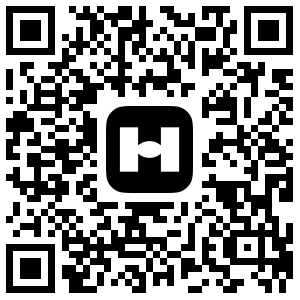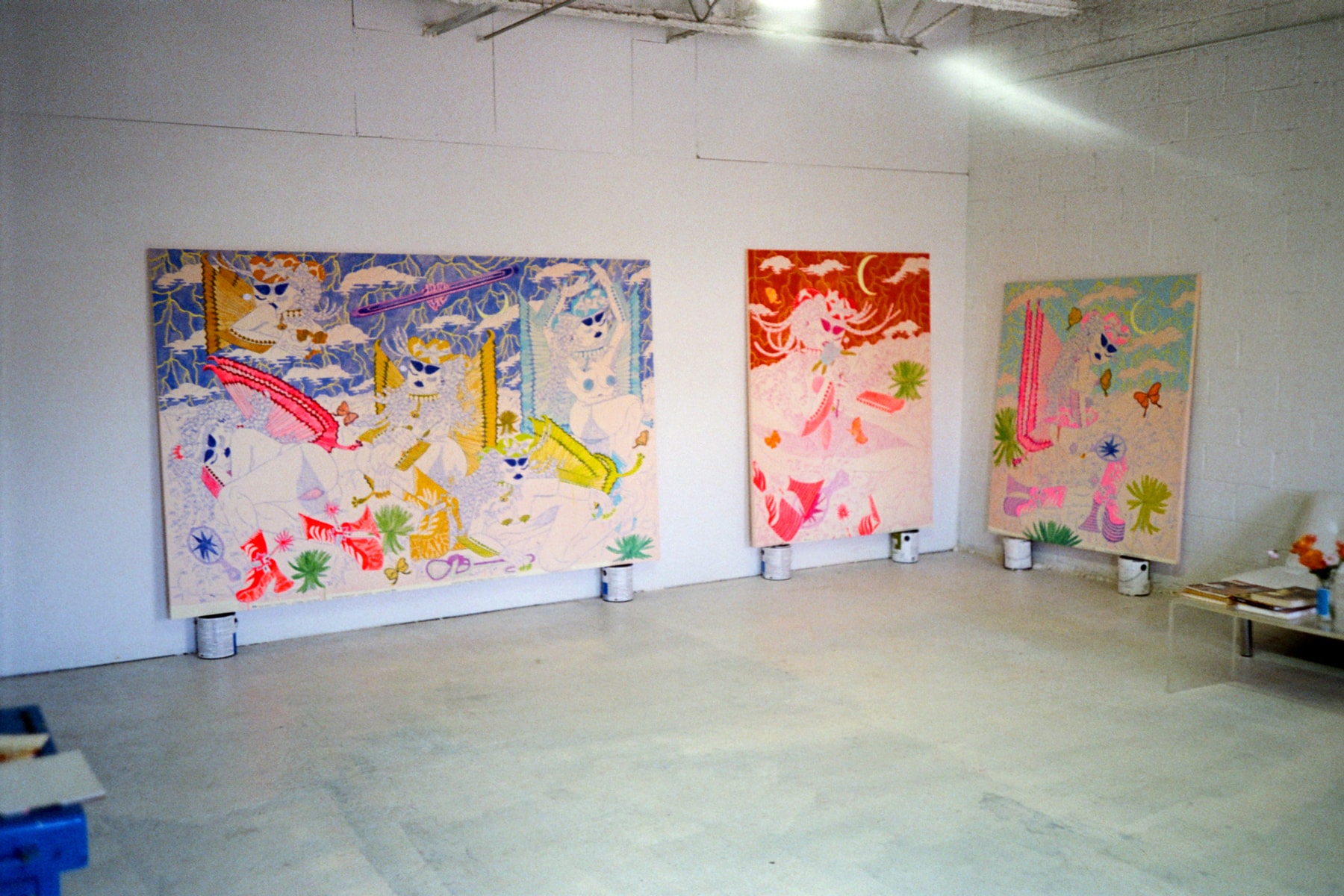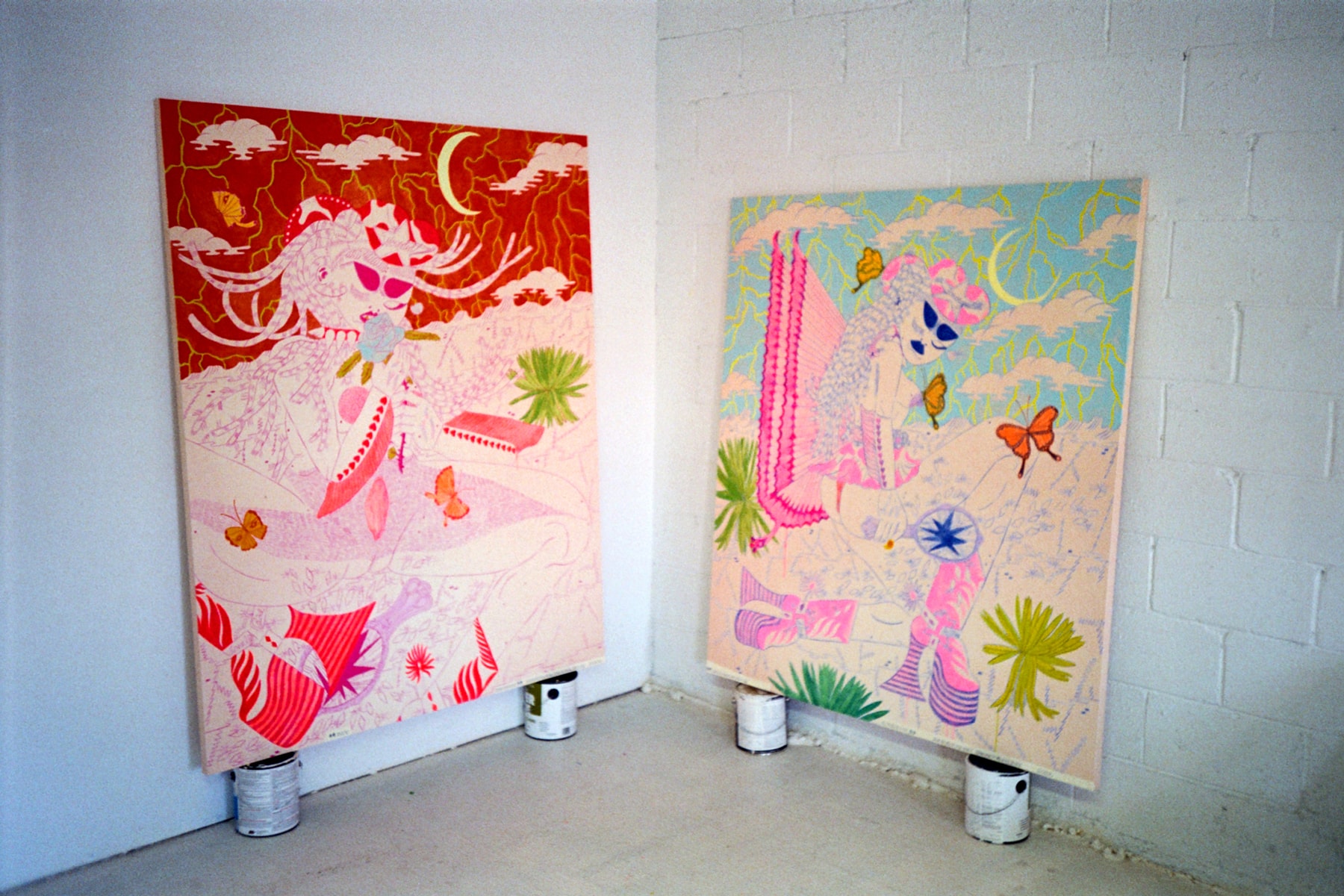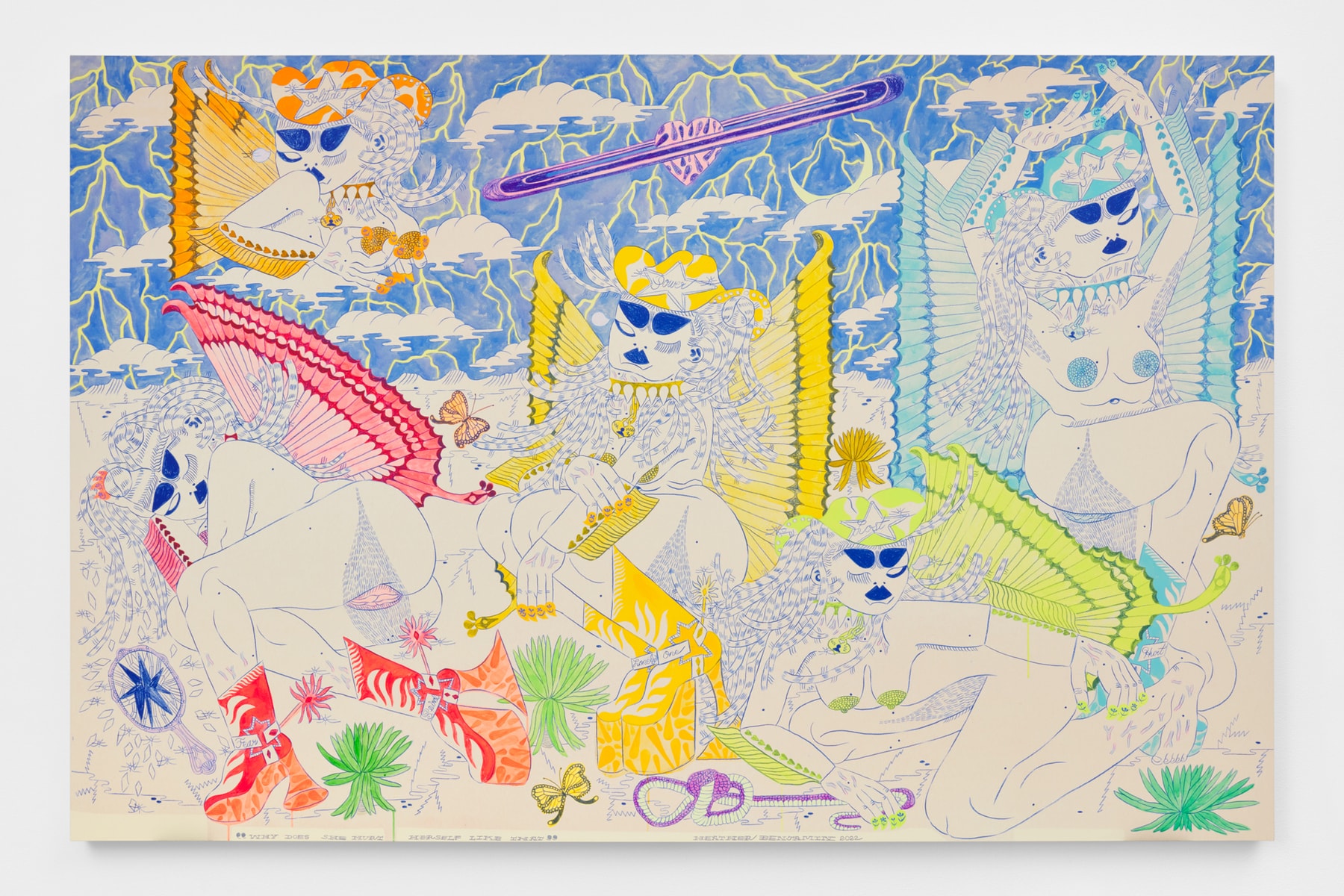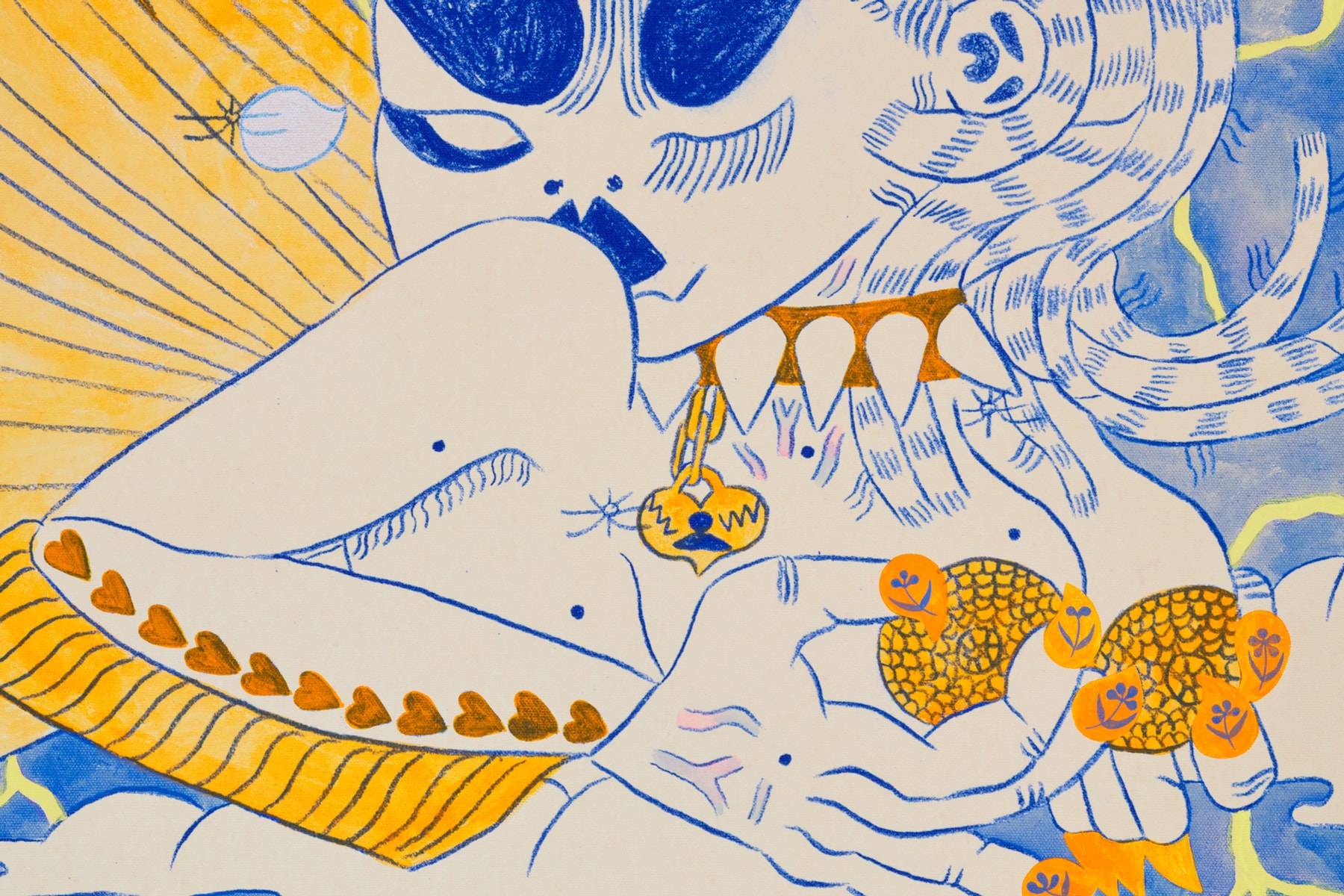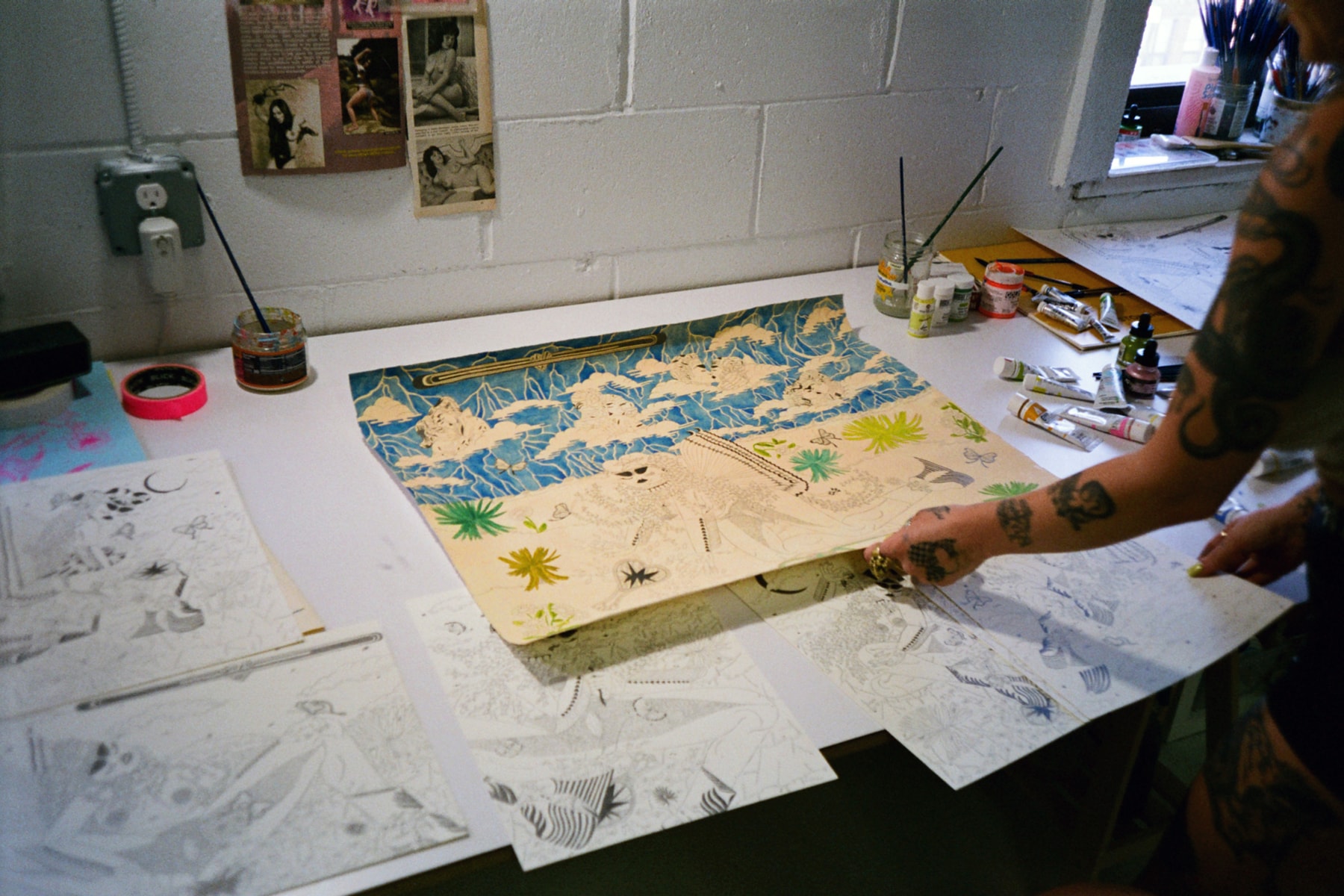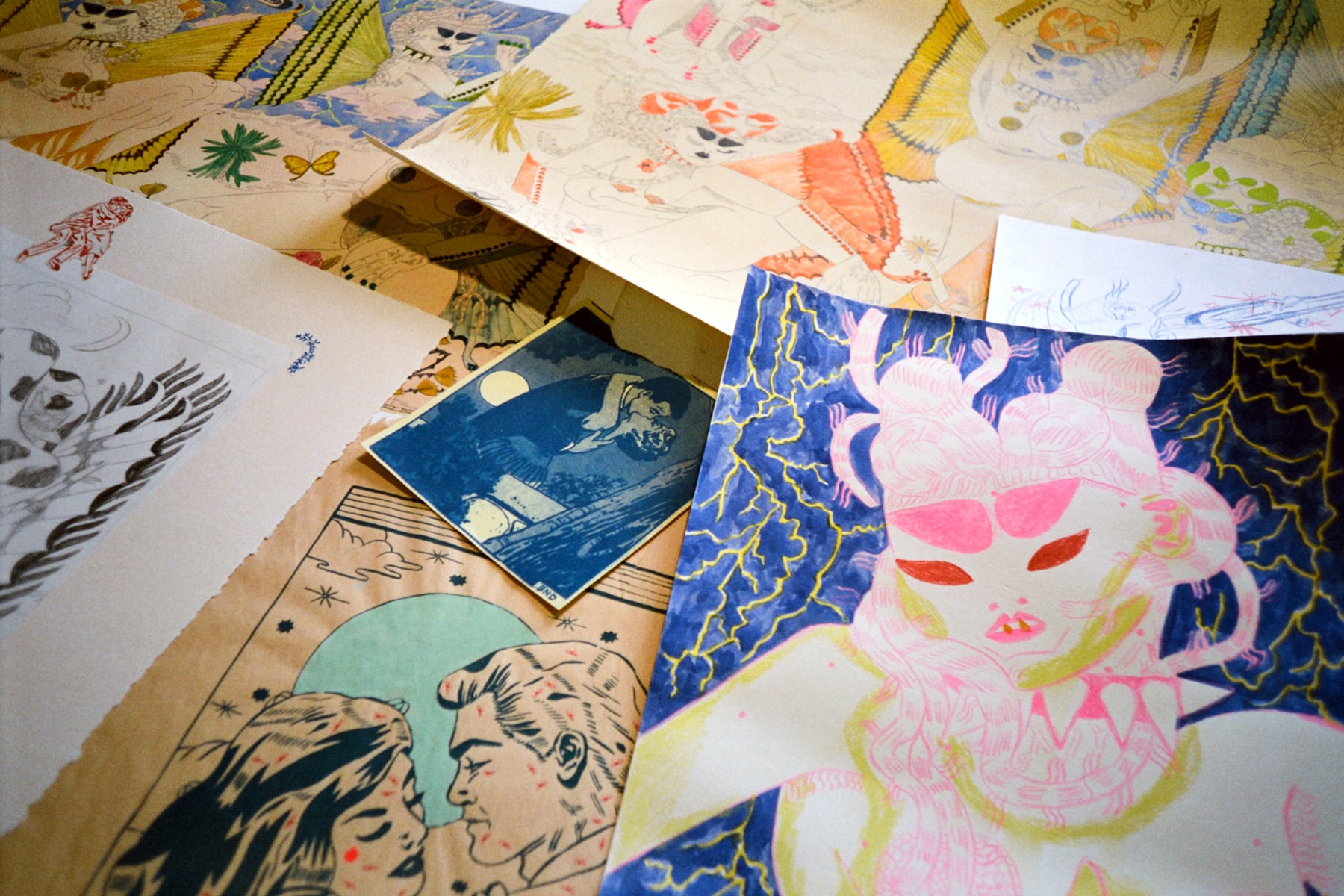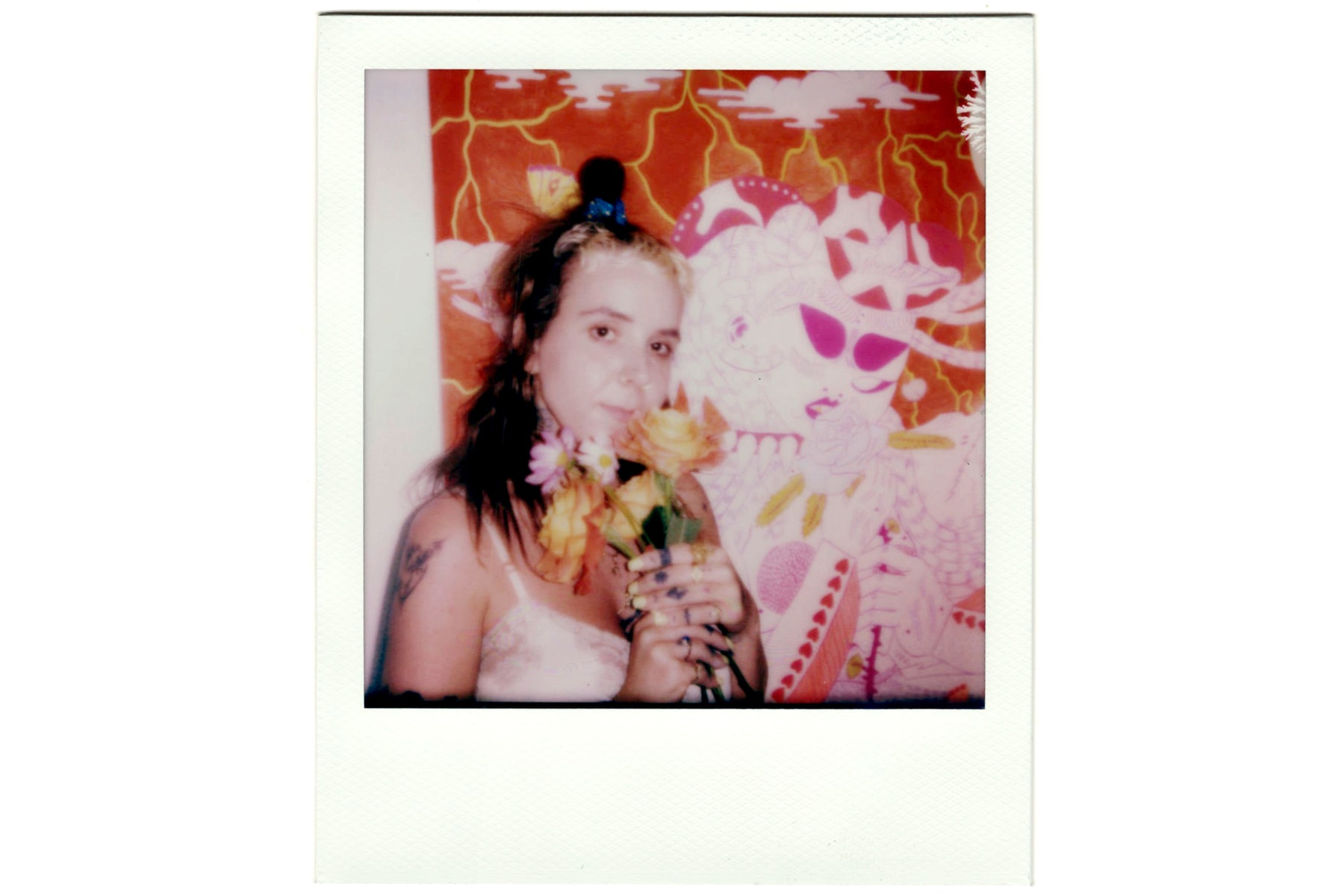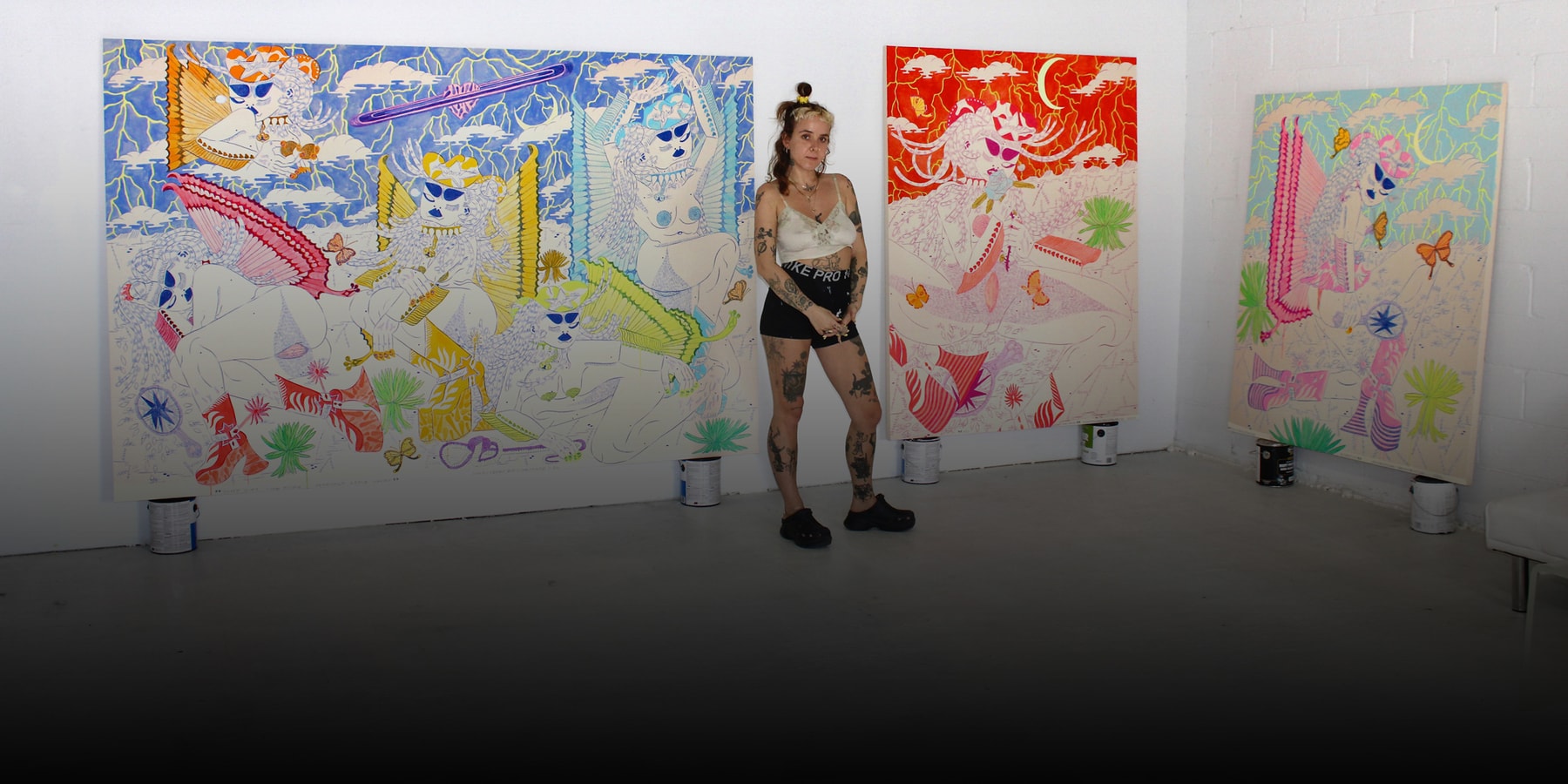
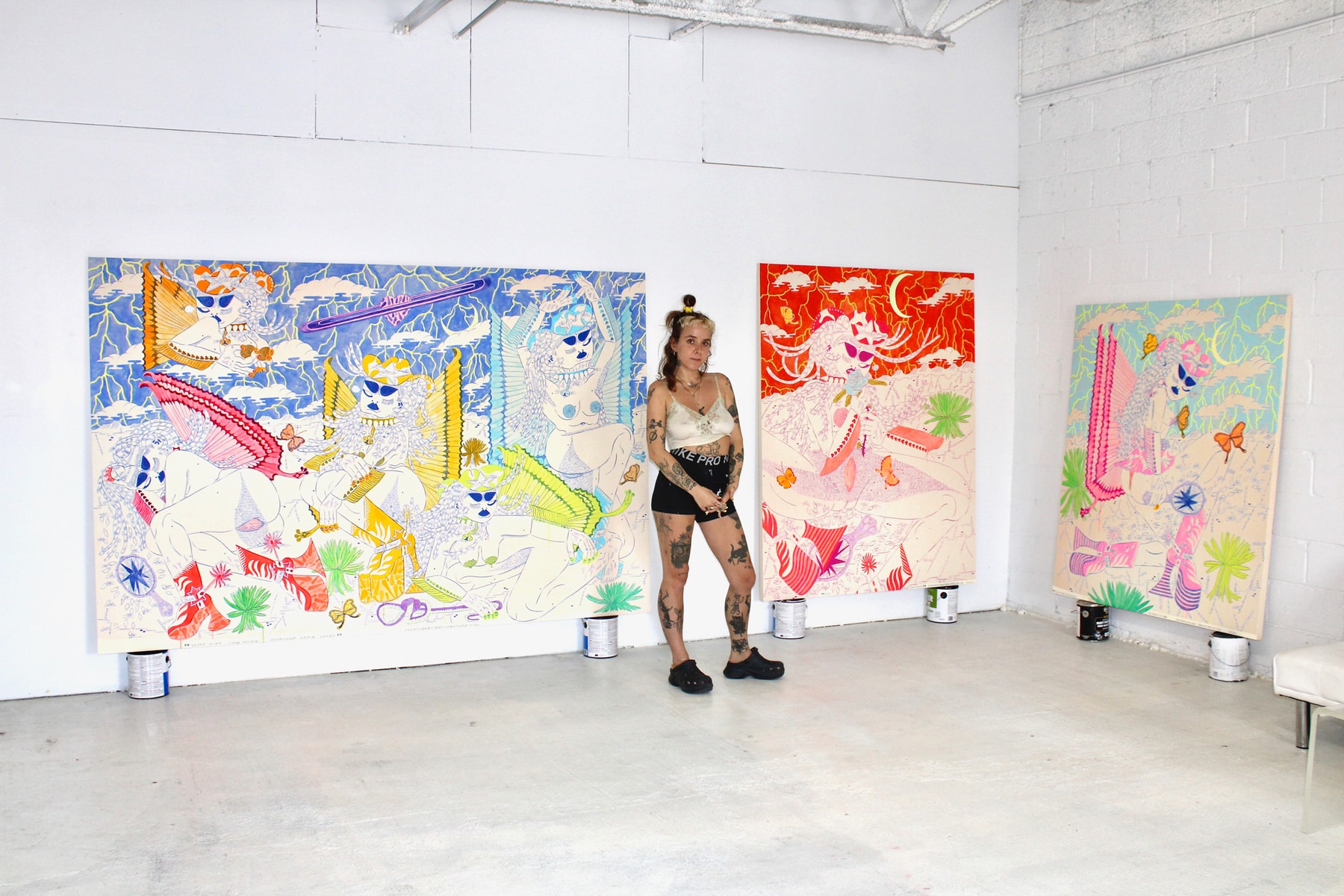
From Titian’s “Venus of Urbino” to Katsushika Hokusai’s “The Dream of the Fisherman’s Wife” as well as Paul Cezanne’s “Seven Bathers,” sexual references in classic works abound. Whether it’s an octopus embracing a nude woman in Hokusai’s piece or Titian’s Venus which Mark Twain once called “the foulest, the vilest, the obscenest picture the world possesses” — the imagery in these works offer no sense of ambiguity regarding their eroticism. The iconography of sex are also present among contemporary works especially in the highly intricate paintings and illustrations of Brooklyn-based artist, Heather Benjamin.
Raised in Queens, NY, Benjamin recounts tracing the exaggerated feminine images of Sailor Moon characters at her grandma’s house when she was a child. “There is a lot about it that is exaggerated versions of traditionally sexualized female body parts, like long legs and big eyes, but there is also a bunch of stuff that’s almost surrealistic about them, the bodies are fairly abstracted, and that’s something I like to play with now too,” she says. Her erotic manga scribblings transitioned into more hardcore scenarios of subjects “fucking and crying” in a series of monochromatic zines called ‘Sad Sex’ that the artist produced during her “super angsty” teenage years. Ripped from vintage porn magazines, her Adderall-induced zine scenes highlighted the unabashed forms of sex with abandon.
As Heather got older, she decided to focus on the nuances of sex and celebrate the female form through a more refined, ambiguous approach. “At a certain point in my personal life I became interested in working through trauma, not ruminating on it,” she says.” The artist recently held a solo show at Brooklyn’s All City Space called ‘BUTTERFLY KISSES.’ Mythical depictions of female characters, akin to goddesses, in her signature motifs are highlighted in numerous large-scale paintings that show women commingling with elements of nature and taming its forces. The works take viewers on a surrealistic exploration of womanhood that recall the artist’s real life experiences that are indicated gesturally.
For our latest Hypeart Visits, we connected with Heather in her Brooklyn studio to discuss her latest works, creative upbringing, and of course, sex. Read our exclusive interview below and let us know your thoughts in the comments section below.
“I was a kid that was always doodling…”
Congratulations on your solo show at All City Space! Tell us about the works in the presentation.
The work I made for this show basically falls into two categories, these larger works on canvas and then smaller works on paper. The latter has been my comfort zone for years, I learned to draw and paint on a small scale working on paper and it’s still something I love, it’s so special to me. I make lots of standalone works on paper that are meant to be seen on their own, but I also make studies for my larger paintings on paper too. The paper drawings in this show are both, if you look closely you’ll see that all four of the compositions on the canvases exist as standalone drawings on the other side of the room as well, plus a handful of other drawings that are just their own thing. My first love in art is really making pencil drawings on paper and often going back into them with gouache or ink, and I don’t think I will ever give that up, it brings me a lot of joy.
The larger canvases in this show are the biggest I have ever made, which was so crazy. It’s something I’ve been wanting to do for a while, make my ladies life size or larger than life, but hadn’t gone for it yet, I felt a little intimidated by the idea even though I’ve also been excited about it for years. It feels good to have finally broken through that anxiety, I’m so excited to keep working at this scale. My concept for them was to approach them materially and compositionally in a very similar way to how I approach smaller works on paper, specifically these very Henry Darger influenced gouache and ink and graphite pieces on paper I’ve been making recently. I thought that would help cushion my landing throwing myself into such a big scale that was foreign to me, and I think that did work! I wanted to make them look like the smaller pencil drawings I color in with gouache and ink, except just blown up like crazy.
Was this the first time you worked on this scale? If so, what challenges did you encounter in the creation process?
The black canvas in the show is a scale I have worked at before, about 4.5 x 5 feet, but the other three are much larger than I’ve ever done. It was thrilling working on them, I’ve been wanting to work big for so long, it was a trip. I actually had a much easier time doing it, as far as making my work on a larger scale, than I had anticipated. I’m a huge over-thinker especially leading up to things I’ve put a lot of weight on, so I think I figured it was gonna be hard as hell because it was such a huge shift but it kind of just wasn’t, it was just fun. I think the hardest part for me was like, literally moving them around in my studio, haha. That being said though, I have already done a lot of work to transition from making small stuff on paper for most of my life to working larger scale/on canvas over the last few years, so a lot of the work was already done in that transition, I think. So this final leap was not a crazy feeling one.
Give us a little bit of background information on yourself. When did your artist journey begin?
I was a kid that was always doodling, all my notebooks and homework from a super young age were so covered in scribbles that I wouldn’t be able to read my notes, so I guess my answer to that is basically as far back as I can remember I was obsessed with drawing. But when I started finding any direction with it, was when I got super hardcore into Sailor Moon when I was 8. My grandma lived in Queens and had some neighbors across the street that were two girls my age that I played with, and they had binders full of Sailor Moon cards, which I had never seen before that. They were so bright and sparkly and inspiring, they really hit hard for me. I think Sailor Moon might have been on Cartoon Network back then but I didn’t have TV growing up so I hadn’t seen that and isn’t how I found out about it. I got so obsessed with these beautiful holographic sparkly cards, and my dad found out from their parents where to take me in Chinatown to go buy them and I started building my own Sailor Moon card collection, and I got to buy the mangas when I was in those stores too.
I got so totally obsessed with the artwork and started drawing that way, in a Manga style, doing Sailor Moon fan art and also making up my own slutty girl superheroes. I think that was the foundation of me making linear, figurative work, and also probably heavily influenced me as far as drawing like, portrait oriented imagery starring a female protagonist with super exaggerated unrealistic body parts and hair and everything… like, those original Naoko Takeuchi drawings are actually so insane, their legs are like 4x longer than their bodies.
Anyway, I think that early Sailor Moon influence just stuck with me hardcore because it’s almost just force of habit at this point, I’ve been making variations on variations on variations of those for years. Of course as I got older it mixed with other influences but that was the starting point and I think it still shows which was kind of a recent and hilarious revelation for me, I don’t necessarily think my current work literally looks like manga or anime whatsoever but I do feel like my figures are flattened and abstracted in a sort of similar way to those forms, because in a way it was how I learned to draw.
“At a certain point in my personal life I became interested in working through trauma, not ruminating on it.”
From the start of your career until now, tell us about the evolution of your works. What sort of subjects were you creating in the beginning and how did they change into the figures we’re seeing now?
I guess my career really started with me making this photocopied zine series called Sad Sex, beginning in 2008. I made ten issues between then and around 2011ish. I had been making art for a long time before that but that was when I started disseminating my work, in zine format, and starting to figure out my style, so I think that feels like the beginning of my career. I was 18 when I started making those zines, so the work was reflective of my 18 year old mental landscape – it was super angsty in a very specific late teens way, it was all about sex and romance feeling twisted and hopeless to me, and the work was extremely graphic. It was all line drawings, black and white, and depicted people fucking and crying, was the entire concept. I was um, going through a lot at the time, haha. The work itself was also really like…meticulous is not the word, more like obsessive. At that time I did a lot of Adderall, I would get so hopped up and just sit at my desk drawing for 12 or 13 hours straight at a time, chain-smoking, until my hand was literally numb. The work reflects that I think, the tiny tiny patterns I got lost in drawing are psychotic looking in retrospect.
As I got healthier as a person over time, and also just got older and my mental landscape changed, my work changed, because my work has always been diaristic. At a certain point in my personal life I became interested in working through trauma, not ruminating on it. As I became concerned with different things and a bit more nuanced in my perception of sex and romance being twisted, less just “fuck it all” about everything, I think my work became more nuanced. I felt less strongly about my work just being a receptacle for me to expel intense bad emotions and thoughts, and more about being a place to work through those things, part of that is a process of expulsion still but as time has gone on I’ve become interested in kind of showing the duality and complication of things more, less just about the abject. The main thing is that I stopped literally drawing people having sex, that just stopped being important to me.
My work still contains a lot of nudity, but I’m not literally drawing partnered sex the way I was before. That was of interest to me at the time, not anymore. Now it’s more about creating these female figures, kind of avatars for different aspects of my mental landscape, who visibly contain multitudes, the abject and the anguish is definitely still there but I want to also try to manifest power and strength and resilience through them too, like goddesses who readily show their human sides too.
From mythological scenes to abstracted visuals of everyday objects, tell us about your sources of inspirations and the themes imbued in your works.
I do use references for poses fairly often — that’s usually pulled from old porn, found photographs, photography books, or photos I take of myself for reference — but as far as the thematic genesis of my works, they feel very organic, like it’s less of a concrete reference point I’m ever using and more just extremely diaristic and personal, whatever I’m feeling and thinking about and working through in my personal life at the time. I guess my formula is basically that there’s a figure – or recently, multiple figures – and I’m placing them in a situation – the setting, the environment, the actions they’re taking, the objects they’re surrounded by — that are intended to tell a story about what that girl is going through, what she’s thinking about, how she’s feeling. It feels like maybe every year or two I pick up a few new symbols for my like, bank of objects I pull from – the 50’s romance inspired couples kissing in clouds in the sky or coming out of flowers, the shattered mirror, the giant boots that have short poems written on their straps, a snake. These moments all hold different symbolism for me, most of them can have multiple meanings, and I like mixing them in different combinations to try to convey different stories.
I always want my girls to be conveying a sense of duality, like I feel in my own life — struggling with difficult negative emotional experiences like body dysmorphia or memories of traumatic incidents, for example, but simultaneously also holding things I view as positive emotional experiences, like feeling connected to nature, being in touch with her sexuality, whatever. I want my work to hold all of these intense, conflicting emotions at the same time, because that’s how I feel. Creating a painting of a woman covered in scratches to me is about the pain of self harm inflicted because she’s so upset with her physical form, but in that same image she’s horny and surrounded by beautiful flowers, it isn’t all bad and she knows that even in the darkest moments. It’s a bit hard for me to write about my own work, because the entire reason why I make my work is because I need to paint and draw these things to express them, otherwise I’d be a writer, haha. I guess I have just always been a person who feels like I feel everything really hard at the same time and I’m trying to depict that in my drawings, because that expulsion of the hard stuff feels good, especially when I can also make it beautiful, make it being experienced by a big strong sexy intense otherworldly cowgirl bitch, it makes me feel better about the fact that I’m going through that too, if she is, we’re in it together. I’m actually in therapy for the first time in my life right now and I think it’s really starting to change my work — because a lot of stuff is coming up to the surface. It’s going to be interesting.
“I feel incredibly grateful for the women and other loved ones in my life and I want to make more work about that.”
Tell us more about the characters we’re seeing in your paintings. What elements do you often find yourself incorporating in your pieces and why?
I use a female protagonist in my work to kind of diaristically represent where I’m at in my life, the things I’m thinking about and working through, like an avatar to meditate on different aspects of my experience, and also to kind of manifest or at least imagine different ways of being through them as well. She kind of naturally morphs through time – there was a period a few years ago where I was feeling very like, animalistic and feral and she was a bunch of different animals with a human face, a sphinx, then a dog, then a fairy, recently she has been this cowgirl/superhero hybrid. Those all kind of naturally evolved through both where I’m at mentally at any given time and what’s the most relatable way for me to express that visually, as well as my visual influences and whatever I’m obsessed with at the moment. The cowgirl “phase” has lasted a lot longer than I expected but I guess I’m not surprised, she really is the perfect vehicle to represent the dichotomous relationship with myself that I have and that I need to express in my work- feeling tough, self sufficient, navigating a lot of roads alone, but at the same time that’s a bit hard and lonely to take that all on yourself, and you can only build up these shells for yourself for so much time before you start to feel really isolated and overwhelmed. But there is still a huge amount of pride in that self sufficiency and at being good at being by yourself. She just holds a lot for me, it’s like, that struggle of trying to figure out at which point does being totally self sufficient and independent become a bit masochistic if you’re basing a lot of your self worth on being able to stand alone.
I needed to take it slow and just do what I could do on my own. Except I took a project from an architecture company in Canada, in Toronto, they were doing a restaurant. And basically, they hired me to do all their art vessels and their lighting. So that was a huge project that lasted me a year and basically helped me buy my kilns and pay for a studio space in New York. I was transitioning from Savannah. So that was the start of it, which was about six years ago. And again, they also didn’t know I was in school. So I just fake it really hard.
I feel incredibly grateful for the women and other loved ones in my life and I want to make more work about that. And like, what could be stronger than one freakish superhero cowgirl, a pack of 10 freakish superhero cowgirls, and I love to try and manifest that kind of strength and resilience for myself through my work, since they really are all little facets of myself. So sometimes those pieces with multiple figures are supposed to be read literally, it’s a scene with multiple characters interacting, but other times, especially with the longer works on paper I’ve been making that have a few figures, I can see them being read as a scroll left to right, and it’s all one character moving through time. And as usual since I like everything I make to be able to be read different ways, my goal is that they can be understood either way.
Depictions of nudity go all the way back to ancient times especially in Greek art when these subjects were used symbolically to display heroes from myths or legends. Nudes are present in your composition. What about the exposed human body interests you as an artist?
It’s funny, I hardly even think about the fact that my figures are nude at this point, it’s just a given to me and I’m totally desensitized to it, and am always caught off guard when someone calls attention to it. I’ve also symbolized and abstracted the parts of my womens’ bodies so heavily that I don’t feel they even read as realistic nudity — like, those nipples do not look like nipples – that I almost forget that they could hold any controversy. I’m going to take this question not as particularly pertaining to painting vaginas and just about nudity as a whole, because that’s partially a different question — I think I mostly make my subjects nude because I’m not really interested in depicting any kind of like, realism, my work is figure based but it isn’t particularly representational if you really look into it. Everything is really heavily flattened and abstracted and proportionally odd, a lot of things I’ve distilled down to very specific symbol type versions of the original thing.
The things I feel strongly about representing in my work are all emotional and heady in a way, and that is very real in its own way, it almost fills the “real” container all on its own, so to me, spending time thinking about and rendering clothing has never really felt like it makes sense with what I’m trying to do with these figures. My figures are stripped down emotionally, going through it in front of the viewer, keeping them in a state of nudity helps to serve that feeling in my opinion. I will sometimes depict them in varying states of undress but even then it’s usually to highlight the fact that there is nudity happening also, haha. It’s just so basic to me that we are all humans with bodies and I’m going to paint that, and if I’m trying to focus on these very deep basic heavy human feelings, clothes can feel distracting. My work also does have a lot to do with sexuality in a multitude of ways, and nudity helps me express that too. Now that I’m thinking about it, it may also be due in some part to the fact that I really care about clothes and fashion in a very specific way in my personal life, so rendering it would be like, actually much higher stakes and more meaningful than just painting a shirt here and there, and since that isn’t what I’m trying to make work about I just avoid it. Whenever I do render clothing, I think A LOT about it, how it serves my message and the image.
“The vaginas that I draw and paint are actually so abstracted in my opinion that I can’t believe anyone would even be offended by them.”
Oftentimes, nude subjects with exposed genitalia can be offensive to some onlookers. Have you ever received harsh criticism for your works? How do you navigate these situations?
Yes, this is something I constantly deal with, in all manner of ways – from my work being censored on the internet/social media, to people saying, I love your work but I just don’t know where I could hang it. The implication there is that since there is female genitalia on view, the work is unsuitable to be displayed anywhere in your home. Sometimes people will explain this away as like, what will I say when my elderly parents come over, but other times there isn’t any further explanation and it leads me to believe that some people just aren’t comfortable themselves looking at it and confronting female anatomy all the time. That is a huge bummer to me, and also feels personally offensive to me because I have a vagina. I take it personally, haha. There are times when I get so down on myself, like, why did I have to choose to feel so strongly about making work that actually seems like it’s fairly indigestible to a lot of people just due to the fact that there are vaginas in it, and then other times I’m like, this is why I feel so strongly about making the work, because it’s insane to me that it’s 2022 and anyone would still react this way to my work, particularly within the art world where it is supposedly so progressive.
The vaginas that I draw and paint are actually so abstracted in my opinion that I can’t believe anyone would even be offended by them. if you really look at them, they look nothing like a vagina. They are completely disproportionate to reality, often painted a completely unrealistic color like blue or green, and look more like an alien flower or some underwater plant than anything else. Or like, an oyster or something. So that’s even more proof to me of everyone’s shame – that even seeing it represented SO abstractly, SO not obviously, it’s still shameful. It’s basically not even a drawing of a vagina, it’s so anatomically incorrect, but the fact that it’s placed in that position on her body, where the real one would be, makes it too much, too easy to think about the real thing. I think that’s one thing that makes my treatment of the vagina different than like, Georgia O’Keefe’s or something, hers are abstracted too, much more heavily than mine of course, but they’re also super zoomed in. I’m sure if she had painted an entire woman and then rendered her vagina the way she did, in the right spot between her legs, maybe she wouldn’t have had the same success she did. It would be too literal.
Describe the atmosphere of your studio when you are working. Are you working on multiple pieces at once? Are you listening to a particular genre of music while creating?
I love working on multiple pieces at once. I usually have at least a couple of smaller drawings going at the same time, as well as a couple of paintings in tandem as well. I just moved into a larger studio space where I can work on even more paintings at once and that feels great. I like having some continuity between a handful of works, which happens if I work on them simultaneously. I’m kind of all over the place with what I listen to, I cycle between obsessions. I’ll go through a few months long phase where I only listen to live talk radio literally all day. Then I get sick of that eventually and listen to only podcasts or only audiobooks for a few months. And then I’ll go through periods where I’m only listening to music. Genre wise I’m all over the place, when I’m listening to music. Lately I haven’t wanted to choose anything specific for myself, so I’ve been just listening to whatever is streaming on NTS or WFMU, the latter of which is an old standby having grown up in New Jersey. Today I’m listening to Pharaoh Sanders since he just passed away and there’s a 24 hour memorial broadcast on a radio station here in New York to honor his life.
“I love the feeling of creating my own little worlds…”
Tell us about the creative process behind one of your newer paintings. Do you have a step by step process?
At any given time I’m usually working on at least a few pencil drawings, around 11×14 inches or so. Those all end up fully resolved and as their own thing, and then I’ll choose one of those to make into a bigger painting and elaborate on. It usually isn’t a straightforward translation, either – like, I’ll use the pencil drawing, even if it’s finished, as just a jumping off point for the larger work, typically just recreating the figure somewhat similarly and then changing everything else. Sometimes I go about things a different way though, where I have a specific idea for a larger work and the pencil drawings I’m making are more like studies for the bigger painting, and they will be a bit more sketchy and less resolved on their own, because they’re just the precursor to the larger work. But typically I do always draw at least something first before working big, whether or not I get to a point of total resolve before beginning on the painting.
As an emerging artist, what goals are you trying to achieve, currently? What are your thoughts on the state of the current contemporary art industry?
My goal has always been to be able to have a good life doing what I love, which is painting and drawing and working on other creative projects. That is still my goal, to keep being able to support myself off of making my work. My goal for a long time was to not have a day job anymore in order to support my art making, and that’s been my reality for the last four years, which is a trip, that I actually got there. It’s definitely rough at times, especially recently since I just got a new studio, financially I don’t feel totally stable in this being my reality yet. But I’ve been able to kick out the training wheels for a minute now, so hopefully I can really stabilize myself within this part of my career soon. I want to make work that feels ambitious and challenging for me, I love the feeling of creating my own little worlds, I just love what I do and always have. I just wanna be able to keep doing this forever.
With regards to the contemporary art industry, I feel like a bit of an outsider, so I’m not sure how much I can speak to what’s really even the state of it. Recently I’ve been a bit more in the more swing of things, but up until recently I kind of just kept my head down, made my work, publicized it as best I could, did independent sales, just everything on my own. I don’t regret having been so independent, but that history has made it so I feel like I have a lot to learn about how things work now that I’m engaging with the art industry a bit more, a lot of the inner workings are very unfamiliar to me. I’ve done things independently for my entire career, without representation or anything like that, so a lot of it has been making it up or figuring it out as I go along. Now that I’m moving a bit more into the contemporary art space, there are constantly things I’m learning where I’m like, “whoa, that’s how that works?”. I don’t love how gatekeepy and mysterious a lot of it can feel, and the entire idea of scarcity culture is in direct opposition to the DIY ethos I grew up on and still feel incredibly strongly about. But, it isn’t all like that, and I’m trying to find a balance, because there is so much about the contemporary art world that I do find wonderful – namely, the incredible amount of exciting, talented, beautiful artists that are working right now, and all the diversity and inspiration within that that I love love love to be around and be a part of.
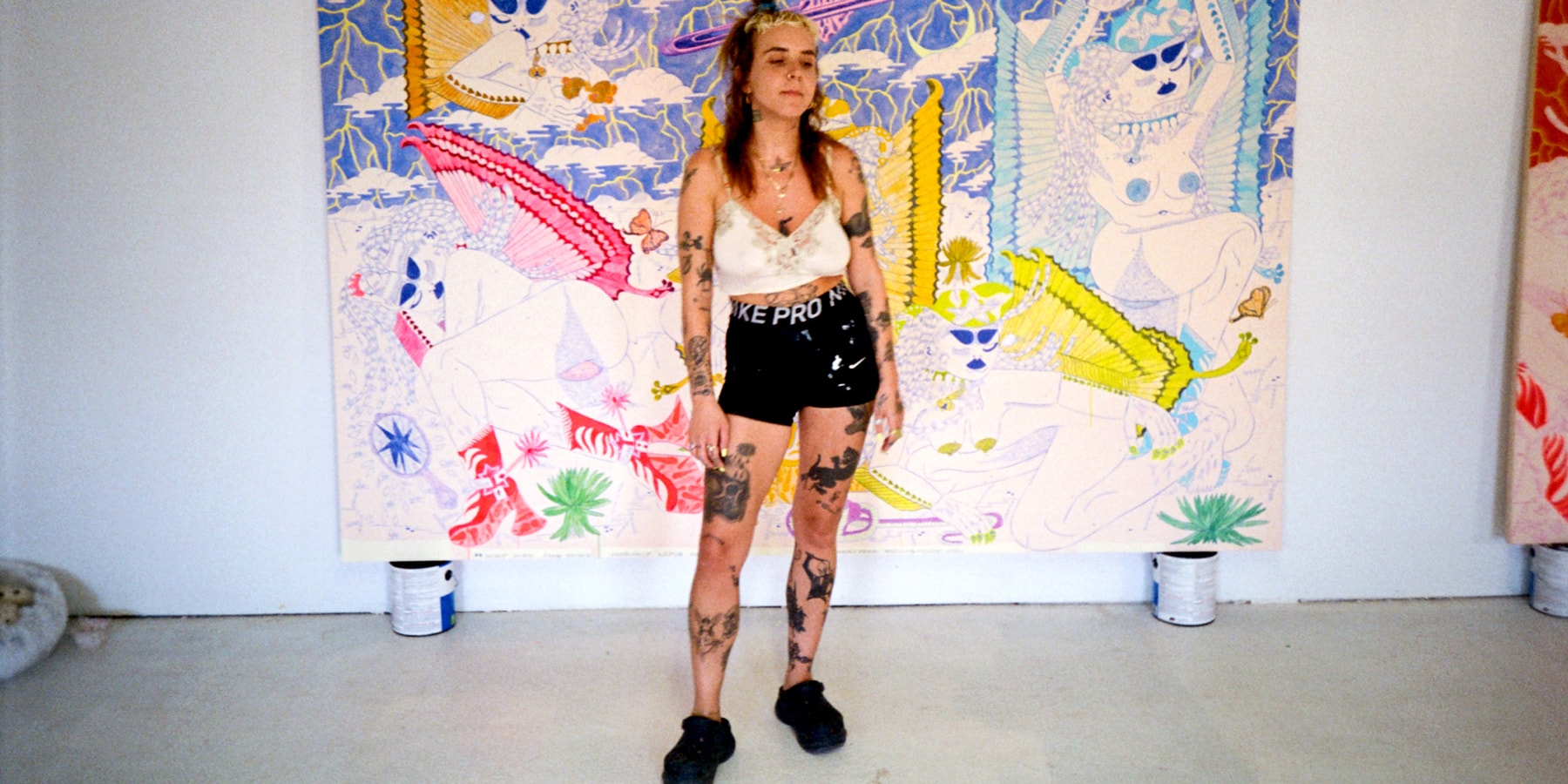
“I would just encourage anyone considering forging this very bizarre and confusing path to just really meditate on how much you love it.”
What advice would you give to those who want to pursue a career as a full-time artist?
You just have to love it so much. Maybe this would be different for an artist who followed a more conventional industry path from a younger age, some of this probably has to do with me coming up through it on my own, but I can’t imagine going through what I’ve gone through to get to this point without just being obsessive about making work, focused on the dream of being able to just make work for the rest of my life, it’s all I want to do, ever. It’s the thing I’m most confident about in the world, in my life, that this is what I want to be doing, and without that drive I think it would have been difficult to make it through the harder moments. I would just encourage anyone considering forging this very bizarre and confusing path to just really meditate on how much you love it. There have been times for me when I’ve dealt with this kind of existential crisis that comes along with the idea of monetizing the thing you love the most, and it can feel really heartbreaking and intense in those moments. But at the same time, it’s the intense love that I have for what I do that is what allows me to climb out of those moments, if that makes any sense.
Apart from your All City Space show. What projects are you working on next?
I have a print edition releasing in the next couple of weeks with Exhibition A. I’m tabling at the New York Art Book Fair in October, which is so exciting, that fair has been such a huge part of my life for a literal decade now and it’s been on hold since the pandemic, so really excited to get back to that community. I have a ceramics residency and concurrent solo show coming up in Paris early next year, and I’m fleshing out my show schedule for the rest of 2023 at the moment. Aside from all that, I’m just looking forward to working on more larger scale paintings in my new studio space, and maybe mess around with learning how to tattoo, which has been on my to do list for a while now.
Photography by Ben Trogden, Leigha Mason and Olympia Shannon for Hypeart
